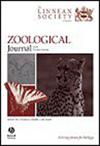化石幼虫的隐秘世界:波罗的海琥珀中一种未成熟蝎蝇(甲壳动物门:Panorpidae)的描述和形态学见解
IF 3
2区 生物学
Q1 ZOOLOGY
引用次数: 0
摘要
迄今为止,在保存完好的鞘翅目化石记录中还没有关于前形象阶段的信息。在始新世波罗的海琥珀中发现了第一只保存完好的蜕翅目幼虫。同步辐射 X 射线显微层析技术的应用使其能够高精度地重建身体结构,提供了一套经典立体显微镜无法捕捉到的全面形态数据。幼虫呈啮蚀状,身体有明显的分段。所有最重要的形态结构都有记录,包括混沌系统。触角的形状和腹节上的环状突起表明幼虫已发育到第三/第四阶段。毫无疑问,该幼虫属于现存甲壳动物中数量最多的泛翅目。从形态特征上看,该幼虫与 Cerapanorpa 和 Panorpa 的幼虫最接近,但化石幼虫不能归入 Panorpidae 的任何现存属。根据同步辐射 X 射线显微层析成像的结果,可以讨论将该幼虫归入比科更低的系统层次,并就始新世泛鳞蜥的生境偏好性质得出结论。本文章由计算机程序翻译,如有差异,请以英文原文为准。
The hidden world of fossil larvae: description and morphological insights of an immature scorpionfly (Mecoptera: Panorpidae) from the Baltic amber
So far, there has been no information of the pre-imaginal stages in the well-preserved fossil record of the Mecoptera. The first and well-preserved mecopteran larva was discovered in Eocene Baltic amber. The application of synchrotron X-ray microtomography enabled the reconstruction of the body structure with high accuracy, providing a comprehensive set of morphological data that classical stereoscopic microscopy could not capture. The larva is eruciform, with distinct segmentation of the body. All the most important morphological structures are documented, including the chaetotaxy system. Shape of antenna and annulated processes on the abdominal segments point to the third/four stage of development. There is no doubt that the larva belongs to Panorpidae, the most abundant family of extant Mecoptera. The morphological characters point to the closest affinity to larvae of Cerapanorpa and Panorpa but the fossil larva cannot be assigned to any extant genus of Panorpidae. Based on the results of synchrotron X-ray microtomography, it is possible to discuss the assignement of this larva to a lower systematic level than the family, and draw conclusions about the nature of the habitat preferences of Eocene panorpid.
求助全文
通过发布文献求助,成功后即可免费获取论文全文。
去求助
来源期刊
CiteScore
6.50
自引率
10.70%
发文量
116
审稿时长
6-12 weeks
期刊介绍:
The Zoological Journal of the Linnean Society publishes papers on systematic and evolutionary zoology and comparative, functional and other studies where relevant to these areas. Studies of extinct as well as living animals are included. Reviews are also published; these may be invited by the Editorial Board, but uninvited reviews may also be considered. The Zoological Journal also has a wide circulation amongst zoologists and although narrowly specialized papers are not excluded, potential authors should bear that readership in mind.

 求助内容:
求助内容: 应助结果提醒方式:
应助结果提醒方式:


